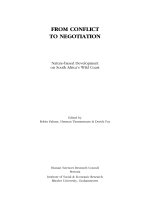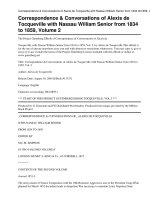From gene to protein
Bạn đang xem bản rút gọn của tài liệu. Xem và tải ngay bản đầy đủ của tài liệu tại đây (1.37 MB, 70 trang )
From Gene to Protein
PowerPoint Lectures for
Biology, Seventh Edition
Neil Campbell and Jane Reece
Lectures by Chris Romero
Copyright © 2005 Pearson Education, Inc. publishing as Benjamin Cummings
• Overview: The Flow of Genetic Information
• The information content of DNA
– Is in the form of specific sequences of
nucleotides along the DNA strands
Copyright © 2005 Pearson Education, Inc. publishing as Benjamin Cummings
• The DNA inherited by an organism
– Leads to specific traits by dictating the
synthesis of proteins
• The process by which DNA directs protein
synthesis, gene expression
– Includes two stages, called transcription and
translation
Copyright © 2005 Pearson Education, Inc. publishing as Benjamin Cummings
• The ribosome
– Is part of the cellular machinery for translation,
polypeptide synthesis
Figure 17.1
Copyright © 2005 Pearson Education, Inc. publishing as Benjamin Cummings
• Concept 17.1: Genes specify proteins via
transcription and translation
Copyright © 2005 Pearson Education, Inc. publishing as Benjamin Cummings
Evidence from the Study of Metabolic Defects
• In 1909, British physician Archibald Garrod
– Was the first to suggest that genes dictate
phenotypes through enzymes that catalyze
specific chemical reactions in the cell
Copyright © 2005 Pearson Education, Inc. publishing as Benjamin Cummings
Nutritional Mutants in Neurospora: Scientific Inquiry
• Beadle and Tatum causes bread mold to
mutate with X-rays
– Creating mutants that could not survive on
minimal medium
Copyright © 2005 Pearson Education, Inc. publishing as Benjamin Cummings
• Using genetic crosses
– They determined that their mutants fell into three
classes, each mutated in a different gene
EXPERIMENT
RESULTS
Working with the mold Neurospora crassa, George Beadle and Edward Tatum had isolated mutants requiring
arginine in their growth medium and had shown genetically that these mutants fell into three classes, each
defective in a different gene. From other considerations, they suspected that the metabolic pathway of arginine
biosynthesis included the precursors ornithine and citrulline. Their most famous experiment, shown here,
tested both their one gene–one enzyme hypothesis and their postulated arginine pathway. In this experiment,
they grew their three classes of mutants under the four different conditions shown in the Results section below.
The wild-type strain required only the minimal medium for growth. The three classes of mutants had
different growth requirements
Wild type
Minimal
medium
(MM)
(control)
MM +
Ornithine
MM +
Citrulline
Figure 17.2
MM +
Arginine
(control)
Copyright © 2005 Pearson Education, Inc. publishing as Benjamin Cummings
Class I
Mutants
Class II
Mutants
Class III
Mutants
CONCLUSION
Gene A
From the growth patterns of the mutants, Beadle and Tatum deduced that each mutant was unable
to carry out one step in the pathway for synthesizing arginine, presumably because it lacked the
necessary enzyme. Because each of their mutants was mutated in a single gene, they concluded
that each mutated gene must normally dictate the production of one enzyme. Their results
supported the one gene–one enzyme hypothesis and also confirmed the arginine pathway.
(Notice that a mutant can grow only if supplied with a compound made after the defective step.)
Wild type
Class I
Mutants
(mutation
in gene A)
Precursor
Precursor
Precursor
Precursor
A
A
A
Ornithine
Ornithine
Ornithine
B
B
B
Citrulline
Citrulline
Citrulline
C
C
C
Arginine
Arginine
Arginine
Enzyme
A
Ornithine
Gene B
Enzyme
B
Citrulline
Gene C
Enzyme
C
Arginine
Copyright © 2005 Pearson Education, Inc. publishing as Benjamin Cummings
Class II
Mutants
(mutation
in gene B)
Class III
Mutants
(mutation
in gene C)
• Beadle and Tatum developed the “one gene–
one enzyme hypothesis”
– Which states that the function of a gene is to
dictate the production of a specific enzyme
Copyright © 2005 Pearson Education, Inc. publishing as Benjamin Cummings
The Products of Gene Expression: A Developing Story
• As researchers learned more about proteins
– The made minor revision to the one gene–one
enzyme hypothesis
• Genes code for polypeptide chains or for RNA
molecules
Copyright © 2005 Pearson Education, Inc. publishing as Benjamin Cummings
Basic Principles of Transcription and Translation
• Transcription
– Is the synthesis of RNA under the direction of
DNA
– Produces messenger RNA (mRNA)
• Translation
– Is the actual synthesis of a polypeptide, which
occurs under the direction of mRNA
– Occurs on ribosomes
Copyright © 2005 Pearson Education, Inc. publishing as Benjamin Cummings
• In prokaryotes
– Transcription and translation occur together
TRANSCRIPTION
DNA
mRNA
Ribosome
TRANSLATION
Polypeptide
(a) Prokaryotic cell. In a cell lacking a nucleus, mRNA
produced by transcription is immediately translated
without additional processing.
Figure 17.3a
Copyright © 2005 Pearson Education, Inc. publishing as Benjamin Cummings
• In eukaryotes
– RNA transcripts are modified before becoming true
mRNA
Nuclear
envelope
DNA
TRANSCRIPTION
Pre-mRNA
RNA PROCESSING
mRNA
Ribosome
TRANSLATION
Polypeptide
Figure 17.3b
Copyright © 2005 Pearson Education, Inc. publishing as Benjamin Cummings
(b) Eukaryotic cell. The nucleus provides a separate
compartment for transcription. The original RNA
transcript, called pre-mRNA, is processed in various
ways before leaving the nucleus as mRNA.
• Cells are governed by a cellular chain of
command
– DNA → RNA → protein
Copyright © 2005 Pearson Education, Inc. publishing as Benjamin Cummings
The Genetic Code
• How many bases correspond to an amino
acid?
Copyright © 2005 Pearson Education, Inc. publishing as Benjamin Cummings
Codons: Triplets of Bases
• Genetic information
– Is encoded as a sequence of nonoverlapping
base triplets, or codons
Copyright © 2005 Pearson Education, Inc. publishing as Benjamin Cummings
• During transcription
– The gene determines the sequence of bases
along the length of an mRNA molecule
Gene 2
DNA
molecule
Gene 1
Gene 3
DNA strand 3′
5′
A C C A A A C C G A G T
(template)
TRANSCRIPTION
mRNA
5′
U G G U U U G G C U C A
Codon
TRANSLATION
Protein
Figure 17.4
Trp
Amino acid
Copyright © 2005 Pearson Education, Inc. publishing as Benjamin Cummings
Phe
Gly
Ser
3′
Cracking the Code
• A codon in messenger RNA
Figure 17.5
Second mRNA base
U
C
A
G
U
UAU
UUU
UCU
UGU
Tyr
Cys
Phe
UAC
UCC
UGC
C
U UUC
Ser
UUA
UCA
UAA Stop UGA Stop A
Leu
UAG Stop UGG Trp G
UUG
UCG
CUU
CCU
U
CAU
CGU
His
CUC
CCC
CAC
CGC
C
C
Arg
Pro
Leu
CUA
CCA
CAA
CGA
A
Gln
CUG
CCG
CAG
CGG
G
U
AUU
ACU
AAU
AGU
Asn
AUC lle ACC
AAC
AGC Ser C
A
Thr
A
AUA
ACA
AAA
AGA
Lys
Met or
AUG start
ACG
AAG
AGG Arg G
GUU
G GUC
GUA
GUG
GCU
GCC
Val
GCA
GCG
Copyright © 2005 Pearson Education, Inc. publishing as Benjamin Cummings
Ala
U
GAU
GGU
C
GAC Asp GGC
Gly
GAA
GGA
A
Glu
GAG
GGG
G
Third mRNA base (3′ end)
First mRNA base (5′ end)
– Is either translated into an amino acid or serves as
a translational stop signal
• Codons must be read in the correct reading
frame
– For the specified polypeptide to be produced
Copyright © 2005 Pearson Education, Inc. publishing as Benjamin Cummings
Evolution of the Genetic Code
• The genetic code is nearly universal
– Shared by organisms from the simplest
bacteria to the most complex animals
Copyright © 2005 Pearson Education, Inc. publishing as Benjamin Cummings
• In laboratory experiments
– Genes can be transcribed and translated after
being transplanted from one species to another
Figure 17.6
Copyright © 2005 Pearson Education, Inc. publishing as Benjamin Cummings
• Concept 17.2: Transcription is the DNAdirected synthesis of RNA: a closer look
Copyright © 2005 Pearson Education, Inc. publishing as Benjamin Cummings
Molecular Components of Transcription
• RNA synthesis
– Is catalyzed by RNA polymerase, which pries
the DNA strands apart and hooks together the
RNA nucleotides
– Follows the same base-pairing rules as DNA,
except that in RNA, uracil substitutes for
thymine
Copyright © 2005 Pearson Education, Inc. publishing as Benjamin Cummings
Synthesis of an RNA Transcript
• The stages of transcription are
Promoter
– Initiation
Transcription unit
5′
3′
3′
5′
Start point
RNA polymerase
– Elongation
– Termination
DNA
Initiation. After RNA polymerase binds to
the promoter, the DNA strands unwind, and
the polymerase initiates RNA synthesis at the
start point on the template strand.
1
5′
3′
Unwound
DNA
3′
5′
Template strand of
DNA
transcript
2 Elongation. The polymerase moves downstream, unwinding the
DNA and elongating the RNA transcript 5′ → 3 ′. In the wake of
transcription, the DNA strands re-form a double helix.
Rewound
RNA
RNA
5′
3′
3′
5′
3′
5′
RNA
transcript
3 Termination. Eventually, the RNA
transcript is released, and the
polymerase detaches from the DNA.
5′
3′
3′
5′
5′
Figure 17.7
Completed RNA
transcript
Copyright © 2005 Pearson Education, Inc. publishing as Benjamin Cummings
3′









